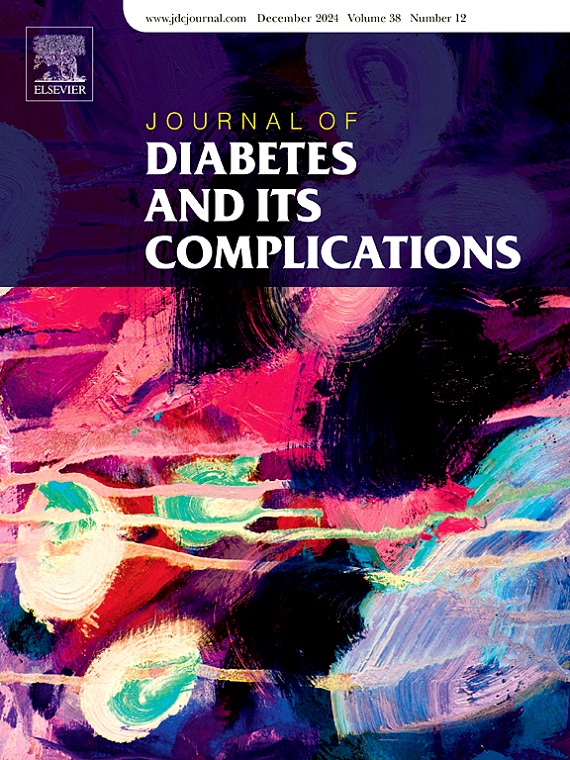Association of aortic pulse wave velocity with cardiovascular outcomes and all-cause mortality in diabetes: A systematic review and meta-analysis
IF 3.1
3区 医学
Q3 ENDOCRINOLOGY & METABOLISM
引用次数: 0
Abstract
Aims
Patients with diabetes have experienced excess cardiovascular (CV) diseases. Accurate prediction of CV risk has been one of the ultimate tasks of contemporary diabetology. Aortic stiffness (AS), a key indicator of vascular health, has been increasingly considered as a valuable biomarker for CV risk and mortality prediction. We sought to investigate and calculate the predictive value of AS measured by pulse wave velocity (PWV) for cardiovascular CV events and/or all-cause mortality for patients with diabetes.
Methods
A comprehensive search was carried out in the PubMed, Embase, and Cochrane Library up to 11 June 2024. We included observational studies where investigators reported the association of PWV with CV events or all-cause mortality in patients with diabetes. Newcastle-Ottawa Quality Assessment Scale was used for quality assessment. Information about study design, participant demographics, baseline characteristics, hazard ratio (HR) and so on were extracted from study documents. Heterogeneity among studies was assessed by using the I2 statistic. Acceptable levels of heterogeneity were defined as I2 < 75 %. Fixed-effects model (Inverse Variance) was utilized for synthesis when I2 < 50 %, and a random-effects model (DerSimonian-Laird) was used when I2 > 50 %. Visual inspection of funnel plots, Egger's test and Begg's test were used to evaluate the existence of publication bias. Trim-and-fill method was further used to identify and adjust for publication bias.
Results
We included 12 studies. For each 1 m/s increase in cfPWV in diabetes population, the risk of a CV events increased by 7 % [HR 1.07, 95%CI 1.02–1.12, 3132 subjects, random-effects model], and the risk of all-cause mortality increased by 7 % [HR 1.07, 95%CI 1.03–1.12, 1700 subjects, fixed-effects model]. Diabetic patients with higher cfPWV had a 1.71-fold increased risk of CV events compared with those with lower cfPWV [HR 1.71, 95%CI 1.22–2.40, 2075 subjects, random-effects model]. Since different studies may have used different modeling methods, we performed a quantitative synthesis for each modeling method separately, which consequently led to variations in subjects sizes.
Conclusions
Despite certain limitations of this study, such as heterogeneity, our findings indicate that PWV could be a strong predictor of future CV events and all-cause mortality in patients with diabetes.
糖尿病患者主动脉脉波速度与心血管结局和全因死亡率的关系:一项系统综述和荟萃分析
目的糖尿病患者有过多的心血管(CV)疾病。准确预测心血管风险已成为当代糖尿病学的终极任务之一。主动脉硬度(Aortic刚度,AS)作为血管健康的重要指标,越来越被认为是预测心血管风险和死亡率的重要生物标志物。我们试图研究和计算脉搏波速度(PWV)测量的AS对糖尿病患者心血管心血管事件和/或全因死亡率的预测价值。方法综合检索PubMed、Embase和Cochrane图书馆,检索时间截止到2024年6月11日。我们纳入了观察性研究,研究者报告了PWV与糖尿病患者CV事件或全因死亡率的关联。采用纽卡斯尔-渥太华质量评估量表进行质量评估。从研究文献中提取有关研究设计、受试者人口统计学、基线特征、风险比(HR)等信息。采用I2统计量评估研究间的异质性。可接受的异质性水平定义为I2 <;75%。采用固定效应模型(逆方差)综合I2 <;50%,随机效应模型(dersimonan - laird)50%。采用漏斗图的目视检验、Egger检验和Begg检验来评价发表偏倚的存在性。进一步采用trim -fill法来识别和调整发表偏倚。结果纳入12项研究。在糖尿病人群中,cfPWV每增加1 m/s, CV事件的风险增加7% [HR 1.07, 95%CI 1.02-1.12, 3132例受试者,随机效应模型],全因死亡风险增加7% [HR 1.07, 95%CI 1.03-1.12, 1700例受试者,固定效应模型]。与cfPWV较低的糖尿病患者相比,cfPWV较高的糖尿病患者发生CV事件的风险增加了1.71倍[HR 1.71, 95%CI 1.22-2.40, 2075名受试者,随机效应模型]。由于不同的研究可能使用不同的建模方法,我们分别对每种建模方法进行了定量综合,从而导致受试者规模的变化。结论:尽管本研究存在一定的局限性,如异质性,但我们的研究结果表明,PWV可能是糖尿病患者未来心血管事件和全因死亡率的一个强有力的预测因子。
本文章由计算机程序翻译,如有差异,请以英文原文为准。
求助全文
约1分钟内获得全文
求助全文
来源期刊

Journal of diabetes and its complications
医学-内分泌学与代谢
CiteScore
5.90
自引率
3.30%
发文量
153
审稿时长
16 days
期刊介绍:
Journal of Diabetes and Its Complications (JDC) is a journal for health care practitioners and researchers, that publishes original research about the pathogenesis, diagnosis and management of diabetes mellitus and its complications. JDC also publishes articles on physiological and molecular aspects of glucose homeostasis.
The primary purpose of JDC is to act as a source of information usable by diabetes practitioners and researchers to increase their knowledge about mechanisms of diabetes and complications development, and promote better management of people with diabetes who are at risk for those complications.
Manuscripts submitted to JDC can report any aspect of basic, translational or clinical research as well as epidemiology. Topics can range broadly from early prediabetes to late-stage complicated diabetes. Topics relevant to basic/translational reports include pancreatic islet dysfunction and insulin resistance, altered adipose tissue function in diabetes, altered neuronal control of glucose homeostasis and mechanisms of drug action. Topics relevant to diabetic complications include diabetic retinopathy, neuropathy and nephropathy; peripheral vascular disease and coronary heart disease; gastrointestinal disorders, renal failure and impotence; and hypertension and hyperlipidemia.
 求助内容:
求助内容: 应助结果提醒方式:
应助结果提醒方式:


